Helen Chadwick is a British installation artist, photographer and sculptor. Her work is heavily influenced by binary oppositions, such as repulsive/seductive and male/female, portrayed via enticing materiality like flesh, chocolate and fur.
Group critique (27.09.16): Death in a box
Critiques, Studio 4The feedback from this silent critique was rather interesting. Main feedback included that the idea of a relationship and lovers, as connoted by stereotypical depictions of romance and passion, was clearly communicated with the work. There appeared to be turmoil between lovers with the contrast of visceral and idyllic objects, that is, the heart and rose respectively. Therefore, this critique brought to my attention that this formal content would not suit my institutional critique practice, despite it being ‘bad art’ in terms of using cliches and literal depictions.
Death in a box (26.09.16)
Practice, Studio 4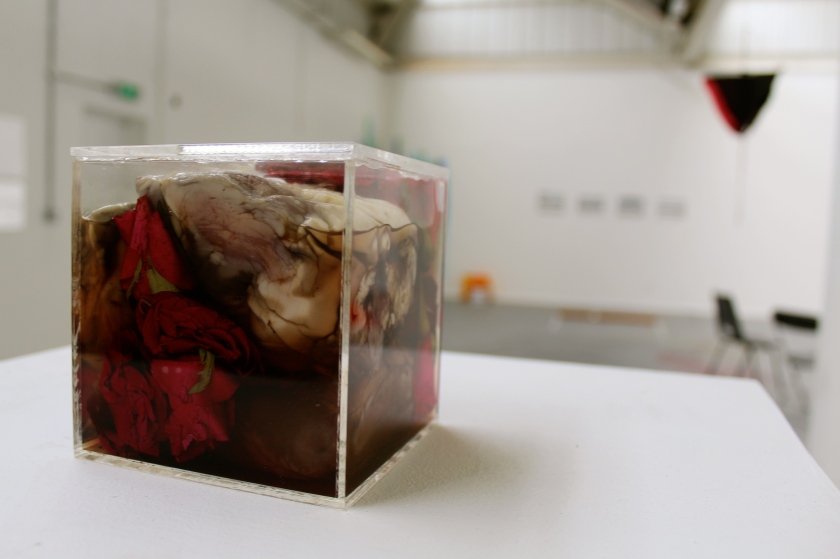
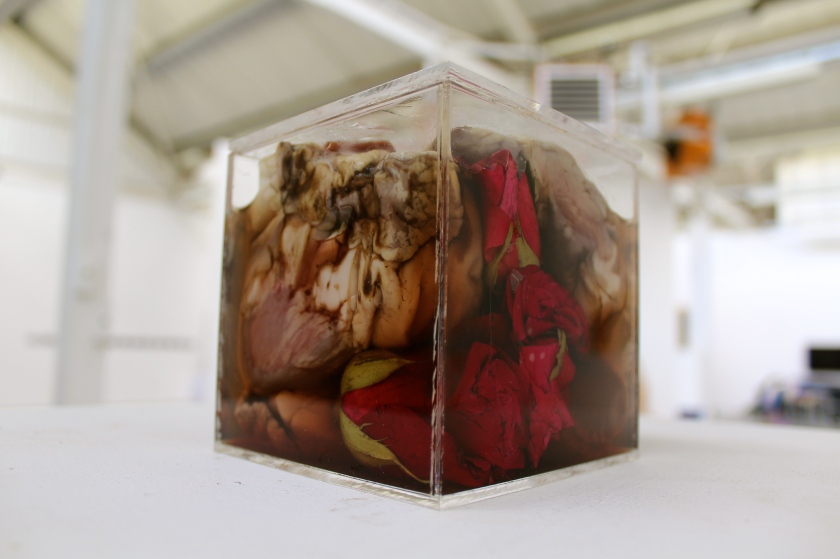
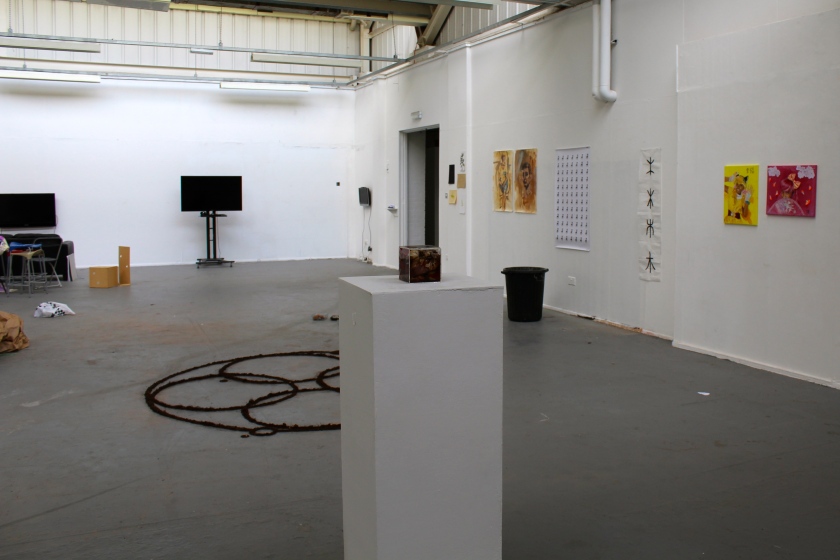
26.09.16 Initial Exhibition
Exhibitions, Studio 4
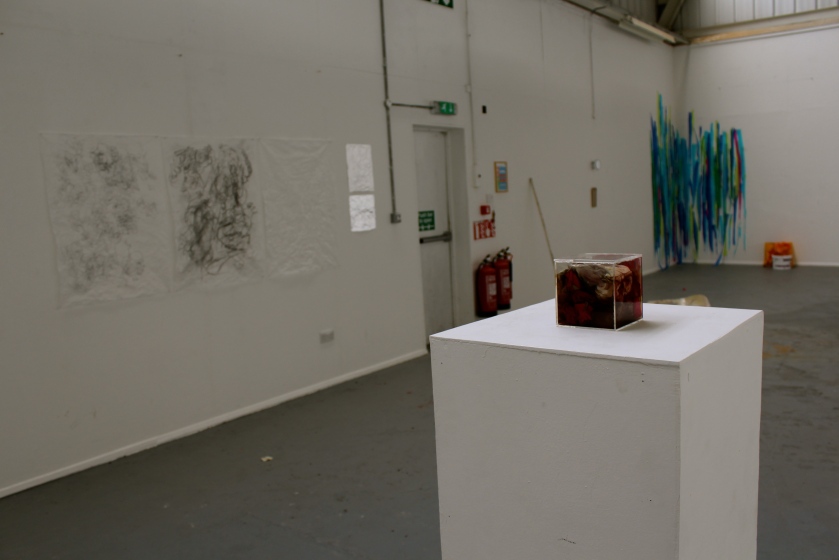

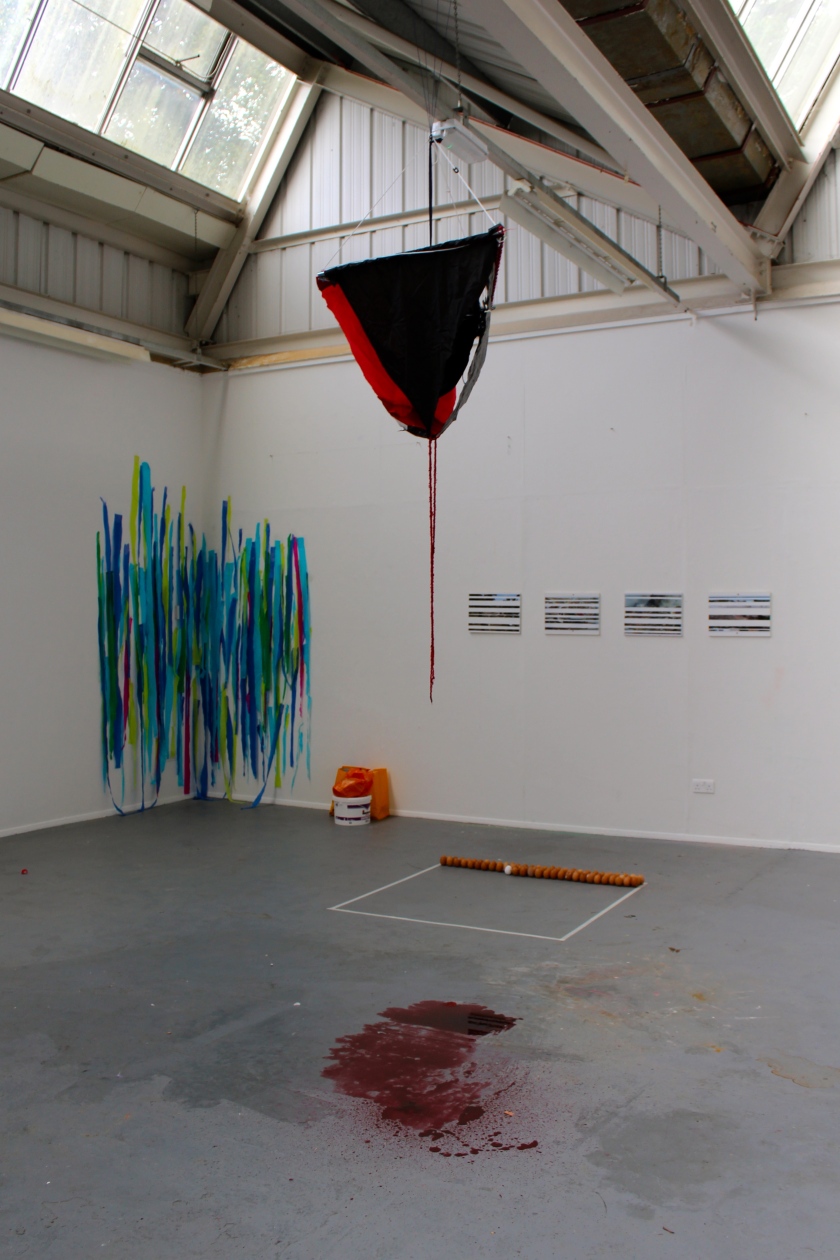
Statement
Studio, Studio 3My practice has evolved in to institutional critique throughout my higher education trajectory. Concerns raised by the processes of scholastic institutions, for example, producing artwork in order to achieve a grade rather than for self-fulfilment, has resulted in exploring the role of the artist and the viewer with regards to subjectivity. Alienated Boredom (2016) is a video that discusses the notion of alienation and boredom from the perspective of the artist and the art-viewer. The voiceover presents both opinions, distinguishable by gender. However, the text is composed in a way that combines the voice of the artist and viewer, so that they can be understood singly and simultaneously. Visually, one is confronted with ideological questions that an educational institution would pose, formatted in the style of a lecture presentation to mimic conventional pedagogic mechanisms.
Although the role of the artist and art-viewer can be differentiated by voice, fragmented opinions that intertwine to make one text creates overlap and confusion between their individual roles. Found text is included within the work to augment the ambiguity of the ‘real’ voice. Excerpts from Herbert Read’s Art and Alienation (1967) and Peter Osborne’s Anywhere or Not At All (2013) are appropriated to provide an older and contemporary, but relevant, theoretical elucidation of both opinions. Text selection instigated from an original text in a previous work, The Emancipated Artist (2016), which stresses the need for an artistic revolution by applying Karl Marx’s notion of a social revolution to the art world. Highlighting frustration at the art institution for dictating rather than facilitating creative practice led to the realisation that the artist is alienated from their product, their artwork, at the hands of the institution. Anywhere or Not At All is incorporated at the end of the text to provide a solution for alienation, postulating the necessity of profound boredom when creating and viewing art.
The viewer faces the work, so they are exposed to the opinion of the artist and the viewer, whilst confronted by an ideal institution. Therefore, the viewer is presented with simulations of opinion, a hyperreality of the artist, the viewer and the institution itself. However, the artist and art-viewer are of equal stance when viewing this work because both must contemplate and decide who and which part of the text reflects the real voice. In doing this, both positions realise the importance of their subjectivity within the art institution, something that is easily forgotten within the discourse of academia. Essentialism of subjectivity for the artist and the viewer will be further explored due to the complexity of the theoretical considerations involved and the significance of the idea.
Alienated Boredom (2016)
Studio, Studio 3The work explores the notion of alienation and boredom from the perspective of the artist and art-viewer. There is a visual contrast of ideological questions that an educational institution would pose. The voiceover is a combination of my own text and appropriated text (mainly Art and alienation, Herbert Read; Anywhere or not at all, Peter Osborne). The work intends to create an overlap or blurring between the voice of the viewer and the artist, but distinct voices have been used to highlight their difference in roles. For the viewer, they are presented with the work so it becomes the viewer hearing the viewer and the artist, whilst confronted by the institution.
A blurring of the artist and the viewer (2016)
Studio, Studio 3I decided to overlap the audio for the artist and viewers opinion in this work to highlight the state of confusion that is caused by their roes. Also inspired by Seers’ overlapping audio and Allan Kaprxw’s Essays on the blurring of art and life (1993) title, I think that this is a rather successful technique because it forces the true viewer of the work to distinguish fact from false and viewer from artist.
The Viewer (2016)
Studio, Studio 3This work explores the perspective of the viewer, with original and found text. Some text was appropriated from Read’s Art and Alienation (1967) and Osborne’s Anywhere or not at all (2013). The somewhat monotone voiceover suggests that a script is being read. I think that this is successful because the physical viewer of the work is made aware that the script is written. Therefore, the viewer must decide the extent to which the voiceover is true or false.
However, the formal imagery within this work needs to be improved. I think Art is opinion (2016) is successful by itself, but the addition of the voiceover is rather authoritative for the viewer, almost telling them what to believe instead of letting them reach their own conclusion. Perhaps a contradictory formal aspect will confuse and entice the viewer, so this is something that I must consider and conceptualise because art should offer a solution, not just present the problem (although art being opinion is what all should realise).
Peter Osborne: Anywhere or not at all (2013)
Studio, Studio 3Osborne is a professor at Kingston University, and his work presents a more contemporary commentary on the art world than that of Herbert Read. In the chapter called, Art Time, Osborne proposes that subjective experience one should try to achieve within the fired of art is that of ‘profound boredom’. So this is possible avenue to be explored. The book itself very dense philosophy and not something that I have been able to complete reading, so this will hopefully be taken further and developed within my art practice next year. However, the notion of ‘profound bored [as] the feeling of possibility itself’ is one that will be carried for this year. Rather than being alienated, the artist and viewer should seek this state of idleness in order to gain greater understanding of their roles and of art. Therefore, one could conclude that the problem of alienation can be resolved with profound boredom.
Jean Baudrillard: Hyperreality (and Death of the Author)
Studio, Studio 3Hyperreality is a theory explored by Jean Baudrillard. He suggested that as a postmodern and media-saturated society, we experienced ‘the death of the real’. Therefore, a postmodern society dwells in the realms of hyperreality. Hyperreality is the overlapping of the real and the simulation so that the two are undistinguishable from one another. Consciously, one is unable to tell reality and the fiction apart. Baudrillard suggested that individuals are more aware and in line with hyperreality, than reality itself. For example, sitcoms and TV shows are simulations of reality, but were are drawn to those more so than our own lives. The concept is closely related to that of ’simulacrum’, a term used to describe a false copy of something. However, Baudrillard developed them term and posited that the notion of a true or false copy no longer exists because we rely so heavily on the media and Internet. Instead, he suggested that the simulations of reality that exist are not any more or less real that the reality which they reflect. Our current day is described as third order of simulacra by Baudrillard because our wold is dominated by simulations. This means that although these simulations may mimic or parallel something else, there is in fact no original. We experienced the death of the real.
In terms of my work, this seems relevant. I am wanting to explore the voice of the viewer and the artist, have them overlap to be indistinguishable. I suggest that as with the death of the real, we are experiencing the death of the artist and the death of the viewer. Barthes suggested the death of the author being the brith of the viewer, sadly my proposition is not as optimistic. Nevertheless, by suggesting that this simultaneous death is occurring, perhaps it will make both parties question their role.